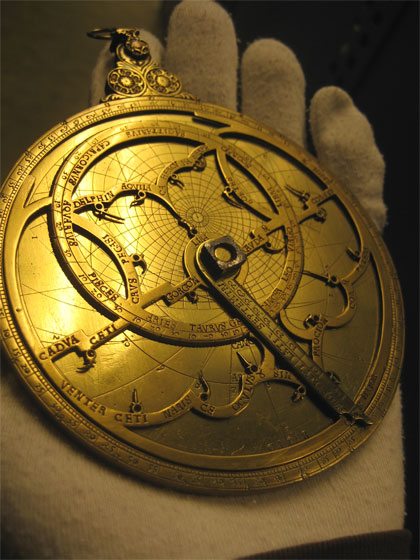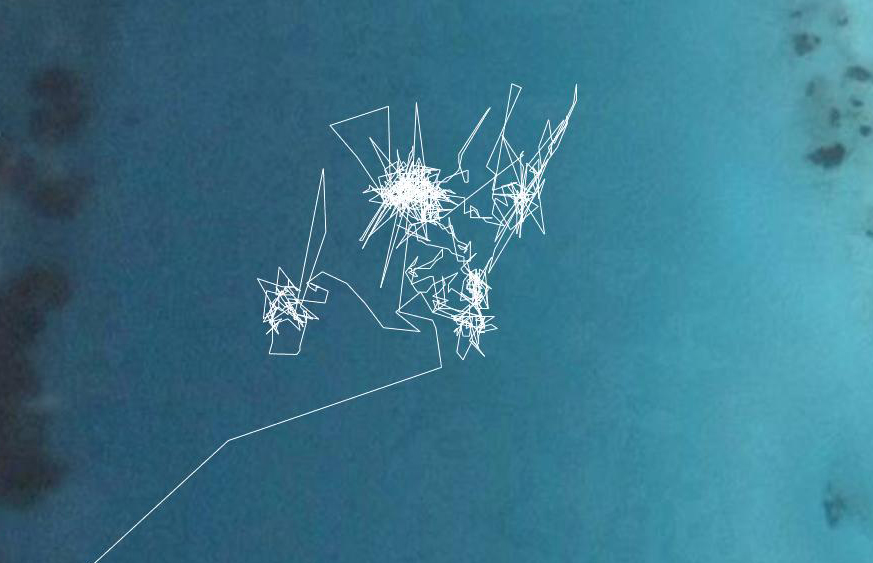[ add comment ] ( 22 views )
I am working towards an ideal of intuitive navigation, where a relation to environment (climate, terrain, landscape) is absorbed into an embodied awareness of location and movement, where advances in technological infrastructures for location navigation and weather prediction also become absorbed into our consciousness. At the moment these new technologies are leading us away from this ideal, because they are seen as functional time saving, economic, problem solving. These attitudes are constraining the development towards an expanded and expansive relation to environment. Through my work as composer and media artist I see the potential for sound to act as a catalyst towards a hybrid intuition of navigation. The refusal of sound to be held down by functional constraints makes it a fitting vehicle to explore this potential hybrid form of knowing and experiencing.
[ add comment ] ( 23 views )
I'm refining my search for a technical approach to creating a portable satellite sounding instrument for Sun Run Sun. I'm looking for a flexible open source solution that has possibilities for future changes and developments, both in terms of hardware and software.
I've had mixed responses ranging from "oh yes that's simple" to "you don't want to do that". I was surprised to find a number of negative responses from 'experts', that I'm being unrealistic to look for custom built hardware of such a small scale and expect good quality stereo sound. I don't think this is true at all, so I find it a strange reaction, maybe stemming from a fear of hardware tinkering? Another reaction is to point me to mobile phones and PDA's with a built in GPS. But this introduces fundamental compromises both on a technical and conceptual level - I don't need any of the complexity of these devices (screen, keyboard, network/phone connectivity, software).
I'm going along the lines of a small processor running Linux and PDa, (a version of Pure Data (often used for electronic music)) parsing the data from the GPS (all NMEA data, not just calculated longitude and latitude) for use as the sound generator. One of the requirements is that I can access and program this sound myself, and I prefer to use Max/MSP or PD for this. I'm pretty excited by Gumstix: tiny computers, motherboards and expansion boards, one of which includes a GPS module, the size of a stick of chewing gum, 20mm x 80mm. This could provide just the solution in terms of size, platform, performance and flexibility for future use.
But more work is needed to find the optimal solution.....
[ add comment ] ( 34 views )
The Leonardo Electronic Almanac special issue on locative media from 2006 has a good collection of papers, overviews and example projects Vol 14 issue 03
[ 2 comments ] ( 39 views )
participating in STEIM's (Studio for Electro-Instrumental Music) orientation workshop in Amsterdam, I'm introduced to their software LiSa for live sampling and processing of sound and JunXion to map controller information from all sorts of input devices to varying sound parameters. It means that I compose, control and improvise on the fly, using sounds that i have stored, record or capture, transforming them into new sounds. And I can gesturally control these sounds in multiple ways including assigning and shaping processes. Which is fantastic because it's flexible and fast.
the draw-backs (arguably) are: it only runs on a mac, works with sound samples not synthesis, is built around the low resolution of midi, and it's not open-source... all side-effects of the fact it's been developed by one programmer over many years for one specific performer.
but then my respect for STEIM lies in it's openness to many forms of instrument and music making, without imposing aesthetics or software choices on the many musicians and artists who become involved in one way or another. so what's the extent of 'open' and 'open-source'?
[ add comment ] ( 19 views )
I was at the start of this round-the-world two handed race that left from Barcelona 3 weeks ago. Here you can follow the continuously updated trace of the boats, get the latest weather reports for their area, and see a google animation of the routes taken so far, there is even a game for you to race against the real boats online (when i checked there were more than 500 'skippers' logged in!) I guess this is a nice example of my talk about the split between embodied experience of location and the virtual - but it's the sailors that are experiencing the hybrid form of location...
[ add comment ] ( 57 views )
follow the moderated discussion from 3 december on the Yasmin Mediterranean Art Science Network list on the theme of locative media art
[ add comment ] ( 19 views )
> a concise overview to celestial navigation
> a nice set by step description of how to make a sun-run-sun
[ add comment ] ( 38 views )
interesting sonification project by Andrea Polli related to climate, weather, environment antartica
[ add comment ] ( 20 views )
Ed Hutchins paper Imagining the Cognitive Life of Things
about the role of multimodal interaction in cognition examined through tasks like collaborative navigation using charts
[ add comment ] ( 20 views )
moderated discussion on the Yasmin Mediterranean Art Science Network list on the theme of the perception of climate change in art and technology
[ add comment ] ( 18 views )
impressions of Mutamorphosis international conference on art and science in extreme environments 8-10/11/2007 Prague. I presented this project on the Eco-Sonification panel...
...towards bodies created, morphed, grown, mutated into other forms and other technologies, resounding with alchemical and astronomical prague, as if these fantasies are becoming real here, as if they could exist. the fantasy becomes reality when Stelarc pulls back his shirt sleeve revealing a surgically modelled third ear on his forearm, and although it can't hear anything yet, the irony of the gesture is curious. the growth of stem cells, bio technologies, nano technologies, astronomists, artists working with these conditions, from micro to macro scales. Roy Ascott talks of arriving at the pharmocological moment. the talks use languages of life, death, feelings, senses, technologies, space, politics, climate, human, anthropomorphic, other, animal, plant. something is in the air, and i hope it is of allowing fantasy to become real, of the alchemical gesture of the supernatural through the physical, the creation of something which becomes something other...
[ 1 comment ] ( 36 views )
An astrolabe from 1525 from Nuremberg - I found it in the archives of the Utrecht University Museum Historical Instruments Collection. It has an engraved ground superimposed by rotating sun and horizon and transferable disks depending on your latitude. You/me are located at the point where the circles converge.

[ add comment ] ( 19 views )
listen to Taking Soundings 2, made out of collected GPS traces from Portugal, Sydney, Holland, Spain, that I made at Steim summer 2007
[ 1 comment ] ( 37 views )
Working on a project like Sun Run Sun I generate a large amount of material and connections that get discarded, or rather, not chosen, in the final presentation of the work. This process of refining is crucial, but I've always looked for a way to let the branches of new ideas have their own life, develop in their own directions, grow and die. Some ideas need to be nurtured, others just take off with their own momentum, others make no impact at all. Instead of locking this process away in a box marked private, this blog aims to open it up and generate a platform for exchange.
Sonic navigations include:
navigation techniques developed by humans
navigation techniques developed by animals
specifics of satellite technologies
landscape and climate
interaction with instrument in an environment
underwater sonar
astronomy
sonification
[ add comment ] ( 22 views )
One integrated portable unit with GPS receiver and sound processor small enough to carry. With this small, light, cheap, durable, strong - the audience can take it out for walks, the percussionist version can walk carrying a loud speaker while playing. (Adapted with a phone card and network it could report back to a central space - but maybe this is against the idea of specific location "I'm here now".) So the time will be spent on developing small portable well designed hardware that runs the GPS and turns this data directly into sound that can be listened to on headphones. What sounds should I use this time? The ring modulations and clicks and white noise?
I am starting to look for a hardware developer/engineer who can design and build this in collaboration with me, and likewise the software needs to be simply developed and open source. Software is sound generation and processing, GPS data parsed to be useful for the sound, bluetooth, storage of data.
[ add comment ] ( 20 views )
Yolande Harris
artist in residence at Montevideo/ Netherlands Media Art Institute, Amsterdam
19/11/2007 - 19/02/2008
Navigations and locations, navigating through locations, locating my navigations, can you navigate?
I am witnessing a sensation of dislocation from my immediate environment by it's alternative representation in the data of position, the figures of longitude and latitude updated every second as I move. What place is there for my sensations, my phenomenology, my conscious and unconscious awareness of space if this knowledge is so efficiently and functionally made redundant by the technologies of satellite navigations?
Looking into historical techniques of navigation this split between environment and location, or location and position is already apparent, although a bridge was present in the direct observation of environment or sun whose data was then used in calculations. The technique called "sun run sun" to chart ones trace across an ocean requires taking three sextant sights on the sun, before during and after its highest point in the day. The data of the suns altitude at a specific time, the speed and direction of the boat through the water, the assumed (estimated) position, and the calculated adjustments from tabulated data, combine to give a location at noon to a variable accuracy.
In my mind, this time consuming technique that is so open to mistakes and so imprecise in its scale of accuracy, in short so much of another age in its priorities, is a perfect starting point to dream of the potential shifts occurring through new navigation techniques. Satellite navigation is being developed in a way that closes down the openness of direct observation and the possibility of mistakes, and the input of choice, intuition and improvisation. At the same time this satellite navigation does not need to be reduced to the mundane but could open us up to a possible consciousness of environment, a hybrid of locative intuition through technology..
This project will be an experiment in drifting, combining the accuracy of the grid with the intuition of movement. Electronic sound is the primary vehicle for exploring these open data worlds because its inherent abstraction refuses to be held down by the functional. Although it is made out of the information it receives from the satellites, this sonification allows us to observe the potentials of our floating extended locations. What is it to navigate? What is it to know I am here now?

[ add comment ] ( 19 views ) | related link

 Archives
Archives




